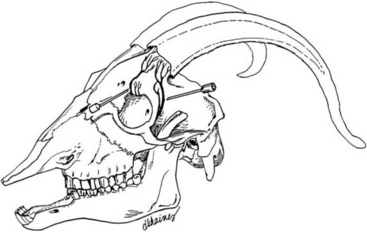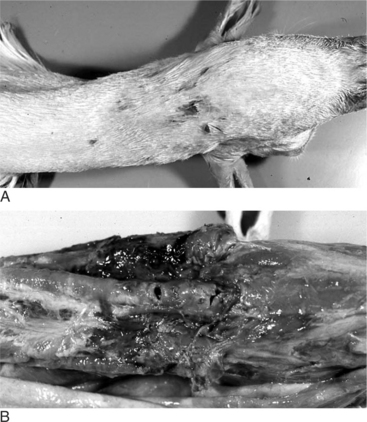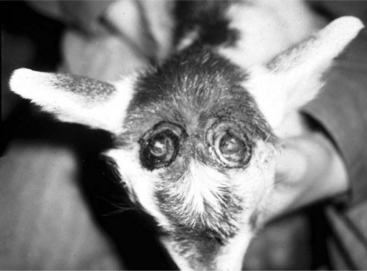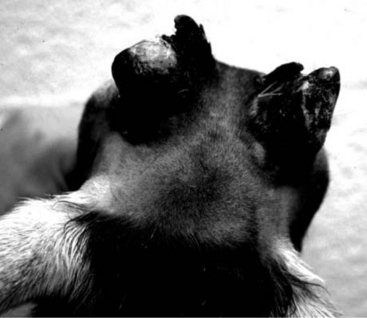Chapter 17 Surgery of the Sheep and Goat Integumentary System
Primarily, three integumentary surgical considerations occur in sheep and goats: skinfold ablation in certain sheep breeds, tail docking or amputation, and wound care that responds to predator attacks in both sheep and goats.
Predator Attack
Sheep and goats are commonly preyed upon by a multitude of carnivores. Sheep are generally attacked more often than goats, just by the nature of production practices and species temperament. Sheep and goat livestock operations near urban areas more often see attacks by domestic dogs. Dogs seem only interested in the chase of a flock or herd and are generally not hunting for food. On the other hand, wild carnivores generally kill livestock for food. It is not common to find survivors from carnivore attacks by any species other than dogs. Also, livestock carcasses are generally partially consumed and dragged to a distant site from the kill. Occasionally an owner will interrupt wild carnivores before they kill their prey, and the veterinary practitioner is called to evaluate the survivors.
Wounds seem to focus in two areas: the ventral cervical region and head, rear limbs, and anus (Figure 17-1 A and B). Repairing fractures and lacerated ligaments in most cases exceeds an animal’s value. All but “pet” animals are many times destroyed. The veterinary practitioner should take adequate precautions to determine the most likely predatory species involved, as hostile litigation and pet destruction is a common outcome. It is common for predator (wild carnivores and domestic dogs) visits to the flock to continue. Rabies in the attacker should always be considered as a possibility, and protective gloves should be worn when dealing with saliva.
Supportive care of the patient is extremely important for healing success. Keeping the animal warm, dry and relatively stress-free are necessary considerations. If the animal is moderately dehydrated, jugular catheter placement and subsequent fluid therapy or blood transfusion is used. If shock is extreme, corticosteroid therapy is indicated (dexamethasone 2mg/kg IV). Myopathy and orthopedic trauma require the use of nonsteroidal antiinflammatory drugs. Flunixin meglumine (12mg/kg IV or IM) or oral aspirin (100mg/kg) (use not indicated in hemorrhaging patients but fairly economical with short drug withdrawal time) therapy is also employed. Broad spectrum antibiotic therapy is indicated where slaughter is not an issue. Antibiotic choices include: penicillin (20,000IU/kg bid), florfenicol (20mg/kg IM EOD or 40mg/kg SQ) and sulfadime-thoxine (55mg/kg IV or po initially then 27.5mg/kg sid) for 5 days. Clients should always receive a written statement concerning withdrawal times and animal care in the advent of adverse drug reactions.
17.1 Caprine Dehorning
Given the complications and costs associated with dehorning, select breeding for polled goats would seem to be advantageous. However, goats have a dominant polled gene closely linked to an infertility recessive gene. Goats homozygous for the polled condition are less fertile because of conditions such as sterile intersex females and a predisposition toward sperm granulomas in males. Breeding programs should account for this possibility, and polled goats should not be interbred to avoid these complications.
Disbudding
RESTRAINT AND ANESTHESIA
The cornual branch of the infratrochlear and lacrimal nerves innervate the horn bud of the goat. A subcutaneous line block along the dorsomedial rim of the orbit blocks the cornual branch of the infratrochlear nerve. The site to block the cornual branch of the lacrimal nerve is located halfway between the lateral canthus of the eye and the posterior edge of the horn along the cornual ridge behind the supraorbital process. Local anesthesia is performed in kids by injecting 1 milliliter of a solution (1 milliliter of 2% lidocaine diluted with 3 milliliters of sterile water) into each of four sites required to block the two horn buds (Figure 17.1-1).

Figure 17.1-1 Injection sites for anesthesia of the horn in goats.
(From Riebold TW, Geiser DR, Goble DO: Large animal anesthesia, principles and techniques, ed 2, Ames, Iowa, 1995, Iowa State University Press.)
SURGICAL TECHNIQUE
Once the dehorner has become cherry red, it should be applied to the horn bud for 3 to 4 seconds while being rocked around the bud. The head should be allowed to cool before reapplying the iron for another 3 to 4 seconds. Two applications of the iron should be adequate to completely destroy the horn corium, and this is assured if a ring of copper-colored skin that encircles the horn bud and cannot be scraped off with a fingernail has formed. The circle of skin inside the ring should be burned as well. Buck kids require a larger ring of burnt skin than doe kids do, and bucks can also be descented at this time by burning an additional crescent of skin caudomedial to each horn bud (Figure 17.1-2).
The most common mistakes associated with using heat cautery include inadequate burning that leads to scur formation (Figure 17.1-3) and excessive burning that leads to heat meningitis. The frontal bone’s thinness and the absence of a frontal sinus at the age kids are disbudded make them prone to heat meningitis. Signs of heat meningitis include unresponsiveness and an inability to nurse. Treatment with antibiotics, antiinflammatory agents, supplemental heat, and tube feeding may allow some affected kids to recover from this condition.
Stay updated, free articles. Join our Telegram channel

Full access? Get Clinical Tree





